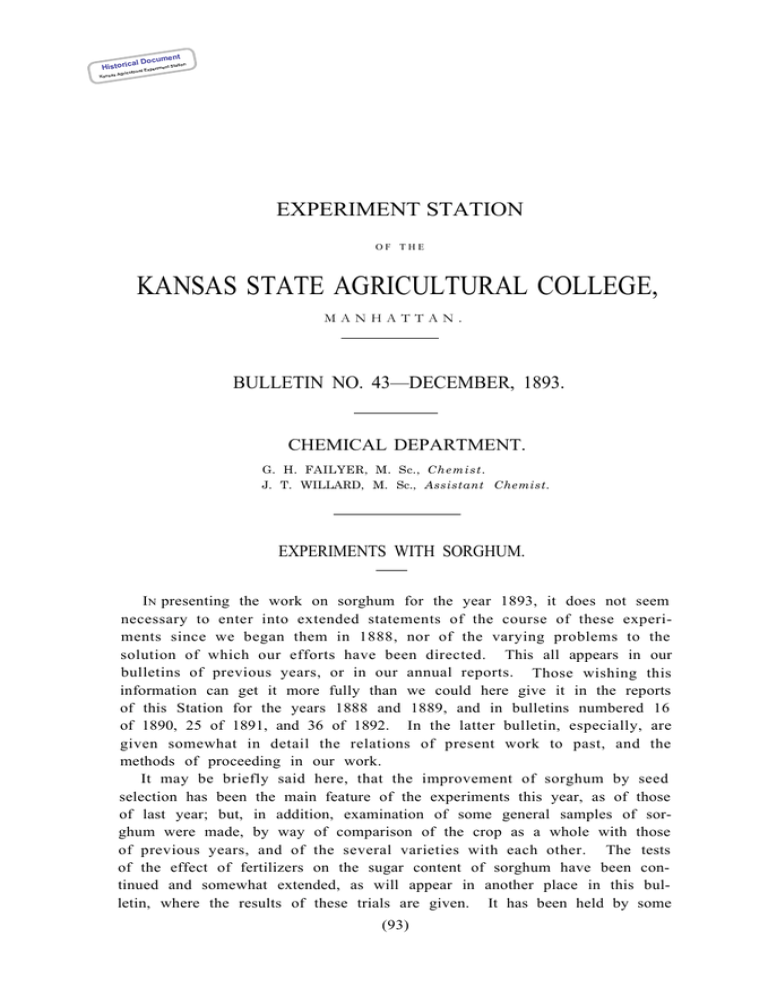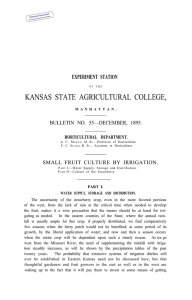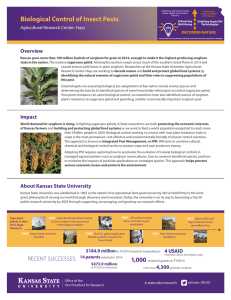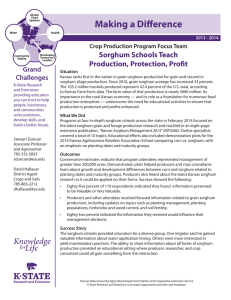KANSAS STATE AGRICULTURAL COLLEGE, EXPERIMENT STATION BULLETIN NO. 43—DECEMBER, 1893. CHEMICAL DEPARTMENT.
advertisement

ument cal Doc tion Histori ural Experiment Sta Kansas Agricult EXPERIMENT STATION OF THE KANSAS STATE AGRICULTURAL COLLEGE, MANHATTAN. BULLETIN NO. 43—DECEMBER, 1893. CHEMICAL DEPARTMENT. G. H. FAILYER, M. Sc., Chemist. J. T. WILLARD, M. Sc., Assistant Chemist. EXPERIMENTS WITH SORGHUM. IN presenting the work on sorghum for the year 1893, it does not seem necessary to enter into extended statements of the course of these experiments since we began them in 1888, nor of the varying problems to the solution of which our efforts have been directed. This all appears in our bulletins of previous years, or in our annual reports. Those wishing this information can get it more fully than we could here give it in the reports of this Station for the years 1888 and 1889, and in bulletins numbered 16 of 1890, 25 of 1891, and 36 of 1892. In the latter bulletin, especially, are given somewhat in detail the relations of present work to past, and the methods of proceeding in our work. It may be briefly said here, that the improvement of sorghum by seed selection has been the main feature of the experiments this year, as of those of last year; but, in addition, examination of some general samples of sorghum were made, by way of comparison of the crop as a whole with those of previous years, and of the several varieties with each other. The tests of the effect of fertilizers on the sugar content of sorghum have been continued and somewhat extended, as will appear in another place in this bulletin, where the results of these trials are given. It has been held by some (93) ument cal Doc tion Histori ural Experiment Sta Kansas 94 Agricult C HEMICAL D EPARTMENT . [B ULLETIN 43 that the percentage of juice yielded by sorghum, and, in an inverse ratio, the percentage of sugar in the juice, is influenced by the moisture in the soil, so that rain following dry weather will cause an increase in the proportion of juice obtained, but that this increase is simply due to a dilution of the juice, the latter being proportionately poorer in sugar. It has been likewise held that the same changes are to be expected in cane cut at different times of day, the drying effects of the sun serving to make a less percentage, of richer juice, in cane cut toward evening than in that cut early in the day. Later in this bulletin are given some results of trials to see to what extent sorghum varies in this way. The weather doubtless influences all crops, and probably sorghum as much as any; it is not known that sorghum is more or less susceptible than other plants. Its ability to stand drought might argue that it is but little affected by the season; but the yield is influenced by the season, and it is quite probable that the quality is likewise. The growing portion of 1893 was somewhat peculiar, whether we regard rainfall or temperature. A p r i l was somewhat above normal, but May was considerably below the mean temperature of this month; June and July were slightly above normal, August considerably below, September and October somewhat above. In considering rainfall, the condition of the ground at the beginning of the growing season is important, so the rain of the winter months may be appropriately mentioned. There was less than the usual rainfall in each of the months of January, February, March, and April, the deficit amounting in the four months to 2¾ inches. May and June were wet, being sufficiently above normal to counterbalance the previous deficit and bring the rainfall for the first half of the year a trifle above that usual during this period. The rainfall was deficient—that is, less than usual—during the remainder of the growing and maturing months, July, August, September, and October. The sorghum was killed by frost on October 15, and operations soon closed. The month of May was cold and wet, so that crops were slow about starting, but other months were favorable, and a heavy crop of sorghum was harvested. The warm, dry weather of the latter part of August, of September and October may be regarded as favorable for the maturing of sorghum; further, the decrease in the proportion of juice from evaporation during such weather may increase apparent richness. Some facts bearing upon this phase of the subject will be given later, in the body of the bulletin. This effect should be kept in mind in examining the following tables; but the evidence is lacking to indicate that any considerable portion of the high quality of our sorghum is to be attributed either to seasons especially favorable to the maturing of the plant or to concentration of the juice by unusual evaporation. Our results and conclusions are confirmed by those at other stations working on the same lines. Those who have given most attention to the subject are fully convinced that sorghum may be greatly improved by culture, crossing, and seed selection; indeed, it ument cal Doc tion Histori ural Experiment Sta Kansas Agricult DEC., 1893.] E XPERIMENTS WITH S O R G H U M. 95 now seems that the plant may be developed or modified in almost any direction desired. In the tables will be noticed analyses of two crosses of Orange and Amber, one of which is distinguished by the name “Colman,” the other by the name “Denton.” The former variety was furnished us several years ago by the United States department of agriculture, the seed being grown at Sterling, this state. This is doubtless a cross of Orange and Amber, but it is distinctly different from the Denton, in that it resembles Orange much more than it does Amber, while the Denton resembles Amber more closely. The department of agriculture has given the name “Colman” to this variety. We have proposed the name “Denton” for the cross of Orange and Amber, which we have brought to its present high state by cultivation for the past six years. In 1887, Mr. A. A. Denton, of Sterling, Kas, selected from their sorghum fields many heads which differed from the varieties among which they grew. Many of them proved to be crosses, and some of them were valuable. The Colman cane was developed at Sterling from seed of one of these selected heads. In the spring of 1888, we procured seed from the selections of 1887, and developed the variety named “Denton.” Mr. Denton’s intimate connection with all work in improving sorghum, and his own efficient efforts in this line, are our reason for selecting this name for this improved variety. Mr. Denton, who has worked for some years in the sorghum experiment station at Sterling, furnishes the following facts regarding the origin of the varieties known as “Nearly Seedless,” “208,” and “8 x.” In 1888, an apparently blighted seed top, one having few perfect seeds, was secured, and the seeds planted in 1889. Many blighted seed tops were produced. Selections in this line have been continued since, resulting in establishing a nearly seedless variety. These selections were made in accordance with the supposition that material which ordinarily goes to make up the seed would appear as sugar if no seed be produced. This supposition agrees with certain experiences in the growth of other plants. No. 208 variety has been developed by preserving the seed of the best canes each year since 1889, when a supposed cross of Link’s Hybrid and Early Amber was planted. The variety 8 x is believed to be a cross of Link’s and Orange, considerably modified by selections. The following brief explanation of terms used in the tabulated statement may be useful, although they are in common use in such connection, and their import will be obvious to most readers: The “dressed cane” implies the stalk after the seed top and the blades have been removed. These are the parts that are removed in preparing sorghum for the diffusers. Many determinations on numerous varieties have shown that the dressed weight is about two-thirds the total weight of ument cal Doc tion Histori ural Experiment Sta Kansas 96 Agricult C HEMICAL D EPARTMENT. [BULLETIN 4 3 the stalks. The per cent. of juice extracted is calculated upon this dressed cane. The “cane sugar” is the sugar of commerce. It is sometimes known as crystallizable sugar. Chemists call it sucrose. The “reducing sugar” is that which is often called glucose. It does not crystallize in sugar making, and carries into the molasses with it a considerable portion of the real, crystallizable sugar. A very desirable character in sorghum is a very small amount of this sugar. The “coefficient of purity” is the percentage of cane sugar found in the total solids in the juice. The higher this is the more perfectly the cane sugar can be separated from the other constituents, and the more desirable, other things being equal, the sorghum is for sugar making. For syrup, a high coefficient of purity is not necessary, and if the solids other than cane sugar consist chiefly of glucose, the cane will be quite as good if not even better for syrup, as it will not be as likely to crystallize. The samples with the large number of stalks in the first table are made up of the juice extracted in making stalk selections. Because of the large number handled, data upon height, weight and weight of juice were not taken, since this would have been necessary with each stalk separately. Agricult t cumen n cal Do tio Histori ural Experiment Sta Kansas D EC., 1893.] E XPERIMENTS WITH S O R G H U M. 97 ument cal Doc tion Histori ural Experiment Sta Kansas Agricult 98 C H E M I C A L D E P A R T M E N T. [B ULLETIN 43 ument cal Doc tion Histori ural Experiment Sta ult Agric Kansas DEC., 1893.] E XPERIMENTS WITH S 0 R G H U M. 99 ument cal Doc Histori Kansas n t Statio perimen ural Ex Agricult 100 C H E M I C A L D E P A R T M E N T. [B ULLETIN 43 ument cal Doc ent Station Histori rim l Expe ura Agricult Kansas DEC., 1893.] EXPERIMENTS WITH S O R G H U M. 101 ument cal Doc Histori Kansas 102 n t Statio perimen ural Ex Agricult CHEMICAL D EPARTMENT . [ BU L L E T I N 4 3 ument cal Doc Histori Kansas DEC., 1893.] n t Statio perimen ural Ex Agricult E XPERIMENTS WITH S O R G H U M. 103 ument cal Doc tion Histori ural Experiment Sta Kansas 104 Agricult C HEMICAL D EPARTMENT . IM P R O V E M E N T BY [BULLETIN 43 S E E D S E L E C T I O N. The selection of individual stalks of special merit has now been in progress for six years. Its success has been less perfect than would have been the case but for circumstances beyond our control, such as drought, flood, and the ravages of insects and English sparrows. Throughout the series of experiments, it has been the plan to preserve average seed, as well as selected, for purposes of comparison, but owing to a variety of circumstances it has not been possible to carry out this plan perfectly, so that nearly all of our present stock of seed has shared more or less in the general result of seed selection and of crossing. It has been impossible to so situate so many sorts as to prevent much crossing. But crossing is one mode of improving, and some of the best sorghums we now have are the result of crossing. Table III presents a comparison of analyses of sorghum grown from average seed and from selected seed. It will be noticed that there has been a marked increase in sugar content, the improvement ranging from about 15 to 40 per cent. of the amounts observed in 1888. We are far from maintaining or believing that this improvement is the result of seed selection wholly, for, although the “average” seed has been largely tinctured by the selected seed, it is not believed to have been sufficiently so to account for all of its increase in sugar. Acclimatization and perhaps favorable seasons the last three years should be allowed considerable weight. Making such allowance, however, there still remains a large improvement which can be accounted for only by admitting the efficiency of persistent scientific seed selection. In comparing the figures of the table for the six years, one should have in mind the very unfavorable season of 1890. As explained in our report for that year, two circumstances interfered with the normal growth of the crop—first, dry, hot weather in June and July, followed by cool, wet weather ument cal Doc tion Histori ural Experiment Sta Kansas Agricult D EC., 1893.] E XPERIMENTS WITH S O R G H U M. 105 in August and September, which caused a renewed growth; and second, an early frost, which caught much of this new growth while immature. In former publications we have enlarged upon the difficulty of improving sorghum by seed selection on mere inspection. No means has yet been observed by which rich canes can be selected by their physical characteristics; a chemical analysis of the juice is necessary. Rough trials can be made by tasting the juice, it is true, and much less rough trials by getting the specific gravity of it; but chemical analysis only can furnish accurate data for judgment. Realizing that it is of very little use to the farmers of the state to demonstrate that sorghum can be improved by seed selection unless the results of that improvement are made available to them, we have preserved a quantity of improved seed from the best varieties, and hold it for distribution to those interested enough to forward postage for a small package, with the understanding that they will report to us the result of the trial. Address all inquiries to G. H. Failyer, Manhattan, Kas. T H E E FFECT OF FERTILIZERS ON S O R G H U M. Our experiment with various fertilizers upon sorghum has now been continued four years. As detailed in previous bulletins and reports,* the plan is to plant sorghum seed of uniform and average quality upon a series of permanently located plats, to which the same treatment is given from year to year. The fertilized plats alternate with unfertilized, “nothing” plats. The same fertilizer is applied to each fertilized plat each year. The kinds and amounts of the fertilizers, with the results obtained, are exhibited in table IV. Unless otherwise noted, the fertilizers were applied in two portions; the first on June 23, and the second August 5. We had been disappointed in not receiving a supply of the potash fertilizer, and hence only one application was made to plat 4. As we had some evidence that sodium nitrate (Chili saltpeter) affected the crop in previous years, it seemed of interest to ascertain what, if any, would be the effect of a much larger application of this substance. It also seemed desirable to learn whether a larger *Bulletins 16, 25, and 36. ument cal Doc tion Histori ural Experiment Sta Kansas 106 Agricult C H E M I C A L D E P A R T M E N T. [BULLETIN 47 application of common salt would lead to favorable results, as that substance is one of the chief mineral products of this state. Each plat contains four rows 3½ feet apart, and the portion fertilized is 62.2 feet long, thus containing one-fiftieth of an acre. The sample for analysis was obtained by taking all the cane growing upon one of the middle rows in a length of 24 feet, where the stand was good. As the yield per acre is calculated from this, it must be accepted with a certain degree of reserve. Attention should also be called to the fact that these weights are of the dressed canes, and are about two-thirds what the weight, including tops and leaves, would be, if the leaves have not been killed by drought to any extent. The samples were analyzed September 29 and 30, the cane being quite ripe and the lower leaves badly dried by drought and winds. The general results are exhibited in table IV, which includes, with other data, the average yield per acre, the average weight of the dressed canes, the per cent. of juice extracted, and the composition of the juice. In table V a comparison is made of the results obtained in the four years that the trial has been conducted. The figures given there are obtained by taking the difference between the results given by a fertilized plat and the average of the “nothing” plats each side. If the fertilized plat gave a higher result, the difference is marked +; if lower, —. In the last column, the average of the differences in the cane sugar for four years is given. Examination of these tables will show that there is nothing to indicate the advisability of applying fertilizers to sorghum grown upon such ground as this, which is upland of moderate fertility. In several cases the yield per acre was increased by the fertilizers, but lime and salt seem to be wholly bad in their effects, reducing the yield of cane per acre and the percentage of sugar in the juice. While in some cases the yield seems to be increased, the difference would not warrant the expenditure for fertilizers; and it is not impossible that these apparently higher yields are not real, but simply result from the unavoidable errors of all plat experimentation. When we consider the figures relating to the composition of the juice, we find no uniformity in the apparent effect of any fertilizer except lime, which has always been injurious. Sodium nitrate (Chili saltpeter) has the best record on the average, but during the last two years has evidently been of no benefit. ument cal Doc Histori Kansas D EC ., 1893.] n t Statio perimen ural Ex Agricult E XPERIMENTS WITH S O R G H U M. 107 108 ural Ex n t Statio ument perimen cal Doc Agricult Histori Kansas C HEMICAL D EPARTMENT . [BULLETIN 43 ument cal Doc tion Histori ural Experiment Sta Kansas Agricult DEC., 1893.] IN F L U E N C E E XPERIMENTS OF THE T IME OF D IN WITH S O R G H U M. AY UPON THE D ENSITY OF THE 109 JUICE S O R G H U M. It has been suggested that there is a variation in the strength of sorghum juice, due to variations in the balance between absorption of water by the roots and its evaporation from the leaves. At night, absorption might be expected to be in excess of evaporation, while during the day the reverse might be true. If this were the case, the juice would be present in greater quantity in the morning, but it would be weaker, and during the day it would become concentrated to a certain extent. If this be true, it would evidently be of the highest importance in selecting the best canes for propagation, as one cut late in the day might seem to be better than one cut early, when really inferior. Having noticed that frequently our best canes were obtained toward the end of a day’s run, and that an almost insignificant shower apparently reduced the density of the juice considerably the next day, a number of analyses were made of lots of sorghum cut at successive intervals during the day. These analyses were combined with the selections of individual canes, the only difference being that each lot, usually 25, was weighed after topping and stripping, and that the total weight of juice obtained from them was also ascertained. If any stalks were very superior, their juice, or most of it, was reserved for individual analysis. The remainder of the juice from each lot was mixed and analyzed. This gave us the data for calculating the average weight of the canes and the per cent. of juice yielded. The juice was analyzed also. These analyses will be found in table I in full, but for readier comparison we have collected them into a separate table which includes only the data necessary to form a judgment upon the question now before us. T h e average weight is given, since smaller canes yield a smaller percentage of juice and juice of a higher density than larger ones, other things being equal. The results appear in table VI. Usually four lots of 25 stalks each were taken, the first being cut at about 8:30 A . M ., and the last about 3 P . M . Of the 10 trials made, in only three cases was the juice from the latest cut cane of greater density than that of any of the other lots, and in two of these cases the last lots were also those having the least average weight. The greatest density was coincident with the least average weight four times, and with next to the least three times, and with the greatest only once. From the above, and the other details included in the table, it will be seen that we have here no evidence that there is an increase of density of the juice with the advance of the day. ument cal Doc Histori Kansas 110 n t Statio perimen ural Ex Agricult C HEMICAL D EPARTMENT. [BULLETIN 43 cumen cal Do Histori Kansas DEC., 1893.] t n t Statio perimen ural Ex Agricult E XPERIMENTS WITH S O R G H U M. 111 ument cal Doc tion Histori ural Experiment Sta Kansas 112 Agricult C HEMICAL D EPARTMENT. [B ULLETIN 43 EXPERIMENTS WITH SUGAR BEETS. Experiments with sugar beets were undertaken on a very limited scale in 1893, and on a somewhat different plan than in previous years. As heretofore, sugar-beet seed was sent to such farmers as asked for it, but no effort was made to increase the number of these. Several localities which had produced the better beets in past years were selected, and a number of farmers in each of these employed to grow a small plat of beets according to our instructions. The greater number of these were in the western portions of the state. The season was so very unfavorable that no results came from most of these. In a number of instances the seed was not planted at all, as it was evidently too dry to bring it up. In some cases the seed was caused to germinate well by a timely shower, but subsequent drought and wind destroyed the young plants. In table VIII are given the results in such beets as were received at the station. The successful plats are too few in number to be of importance, but all results are published, in accordance with our established custom. Table VII gives the results of our trial with sugar beets at the Station, and some comparisons with previous crops. The main field is 20 rods across. The ground is slightly lower near the center, this portion furnishing surface drainage for adjacent ground. From each of the two kinds of beets grown three samples were taken—one from the higher ground at the east end, one from central lower ground, and one from the higher ground on the west. In the table these samples are indicated respectively by E., C., and W. ument cal Doc tion Histori ural Experiment Sta Kansas Agricult D E C., 1893.] E XPERIMENTS WITH S U G A R B E E T S. 113 ument cal Doc Histori Kansas n t Statio perimen ural Ex Agricult 114 C HEMICAL D E P A R T M E N T. [B ULLETIN 43





